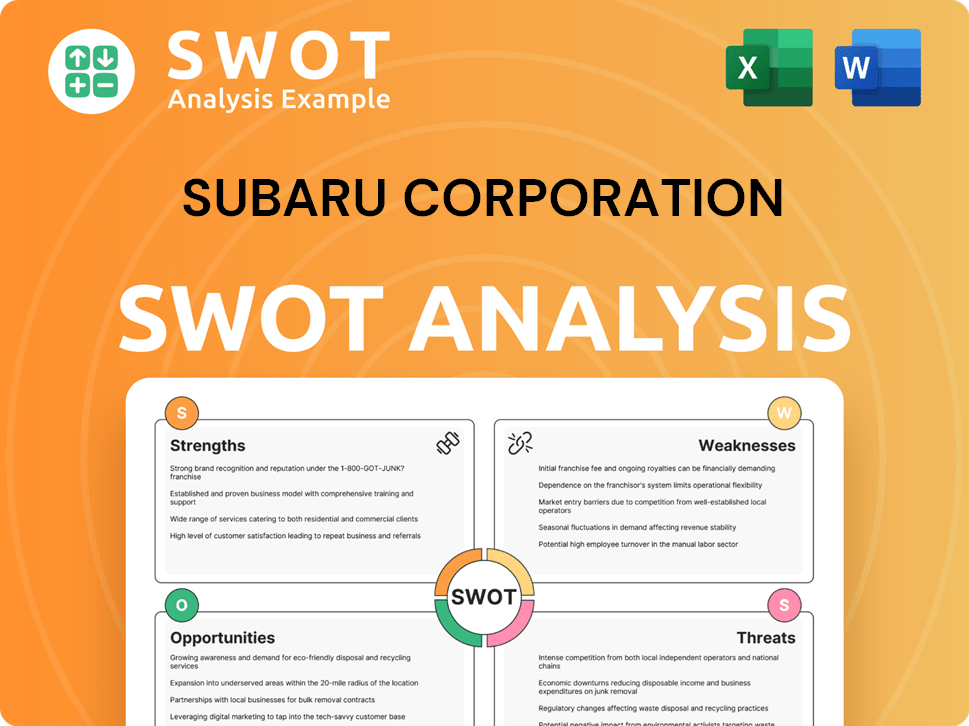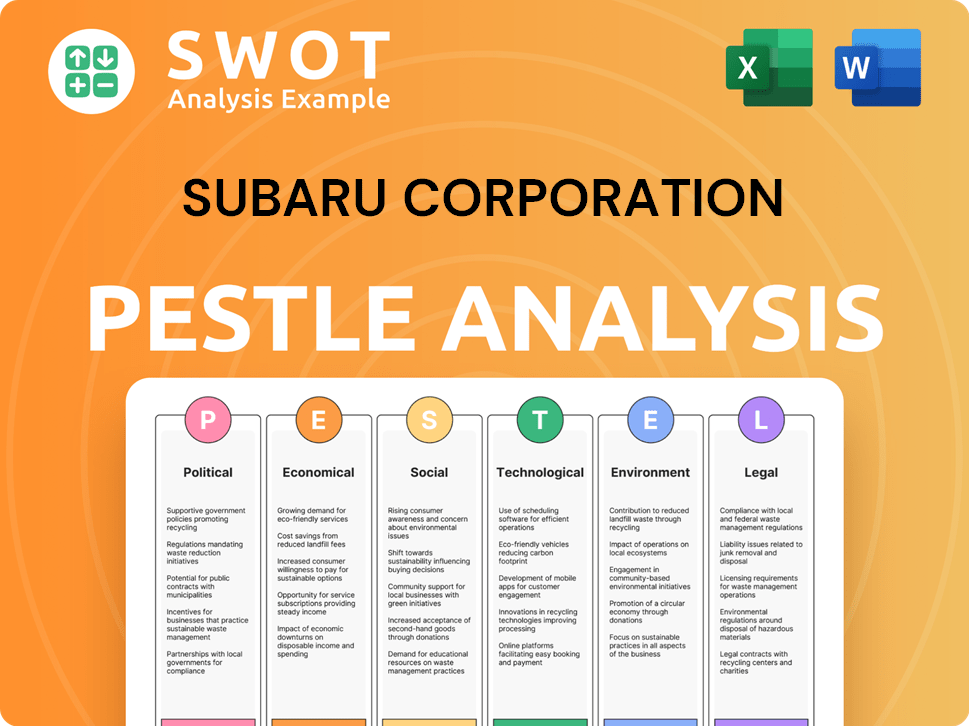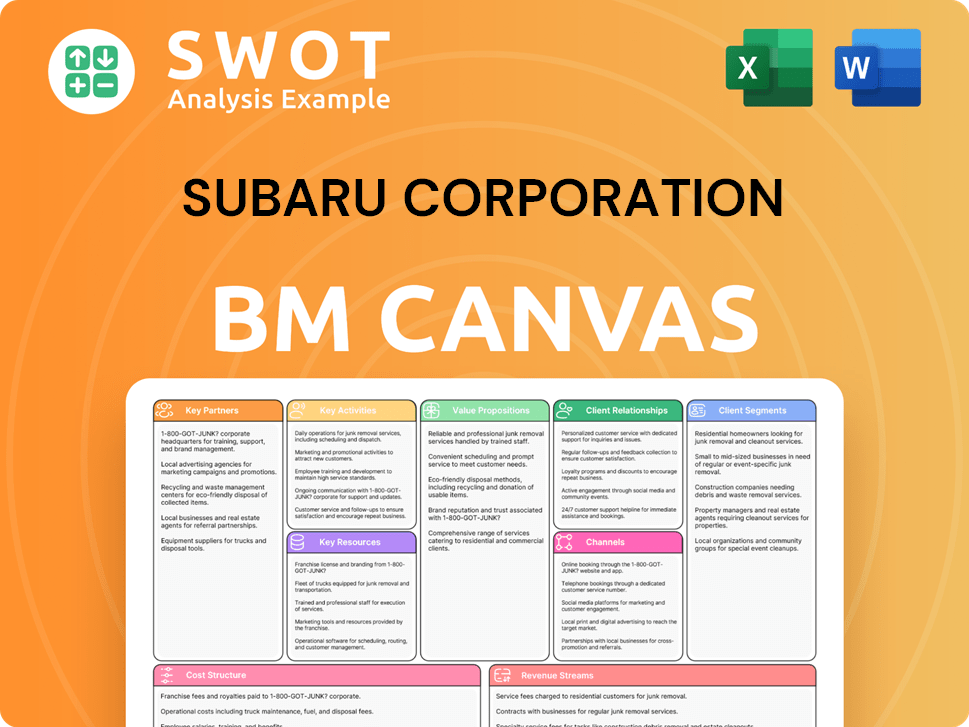Subaru Corporation Bundle
Can Subaru Corporation Drive Future Growth in a Changing Automotive World?
Subaru Corporation, a name synonymous with innovation and reliability in the automotive world, has a rich history dating back to 1953. From its origins as Fuji Heavy Industries to its current global presence, Subaru has consistently delivered vehicles known for their distinctive boxer engines and Symmetrical All-Wheel Drive. This exploration dives deep into the Subaru Corporation SWOT Analysis, its strategic approach, and how it plans to navigate the evolving automotive landscape.

Subaru's future prospects are closely tied to its ability to adapt and innovate within the dynamic Subaru automotive industry. The company's success in North America, a key market, highlights the effectiveness of its targeted approach. This analysis will examine the company's Subaru growth strategy, including its expansion plans, technological advancements, and financial performance, providing insights into its long-term growth potential and investment opportunities. We'll also explore Subaru's electric vehicle strategy and how it aims to maintain its competitive edge through strategic partnerships and collaborations, offering a comprehensive Subaru market analysis.
How Is Subaru Corporation Expanding Its Reach?
As part of its Subaru growth strategy, the company is actively pursuing several expansion initiatives designed to boost future growth. These initiatives focus on broadening its geographical reach and diversifying its product offerings, particularly in the burgeoning electric vehicle (EV) market. A key element of this strategy involves strengthening its presence in its core markets while cautiously exploring new opportunities.
The company aims to enhance its sales network and improve customer experience in North America, a crucial region where it consistently achieves strong sales. Subaru future prospects include introducing new models, including more electrified vehicles, to meet evolving consumer demands and regulatory requirements. This includes expanding its EV lineup, building on models like the Solterra, and developing a dedicated EV platform.
To diversify revenue streams and stay ahead of industry changes, Subaru Corporation is also investing in new product categories and technologies. This includes a significant push towards electrification, with plans to introduce four new battery electric vehicle (BEV) models by the end of 2026. The company's expansion plans are designed to attract new customers, especially those seeking sustainable transportation solutions, and to ensure compliance with increasingly stringent global emissions standards. The company is exploring new business models, such as subscription services or enhanced connectivity features, to generate recurring revenue and deepen customer engagement. For a deeper dive into the company's origins, check out this Brief History of Subaru Corporation.
Subaru is concentrating on strengthening its position in North America. This involves enhancing its sales network and improving the customer experience. The company aims to increase its market share in this key region through new model releases and improved service offerings.
The company is significantly investing in its electric vehicle strategy. This includes the introduction of new BEV models and the development of a dedicated EV platform. The goal is to meet growing consumer demand for sustainable transportation solutions and comply with emissions regulations.
Subaru is exploring new business models to generate recurring revenue and enhance customer engagement. This includes subscription services and enhanced connectivity features. These initiatives aim to create a more connected and valuable experience for customers.
The company is leveraging strategic partnerships, such as the collaboration with Toyota on EV development. These partnerships help share expertise and resources. This accelerates the product pipeline and mitigates development costs.
Subaru's expansion strategy focuses on geographical growth and product diversification, especially in the EV market. The company aims to strengthen its presence in core markets while cautiously exploring new opportunities. These initiatives are crucial for long-term growth and market competitiveness.
- Enhancing sales and customer experience in North America.
- Expanding the EV lineup with new models and platforms.
- Introducing four new BEV models by the end of 2026.
- Aiming for BEVs to account for 50% of global sales by 2030.
- Exploring new business models like subscription services.
- Leveraging partnerships, such as the collaboration with Toyota.
Subaru Corporation SWOT Analysis
- Complete SWOT Breakdown
- Fully Customizable
- Editable in Excel & Word
- Professional Formatting
- Investor-Ready Format

How Does Subaru Corporation Invest in Innovation?
The innovation and technology strategy of Subaru Corporation is central to its future growth, with a strong focus on electrification, advanced driver-assistance systems (ADAS), and digital transformation. This approach is designed to meet evolving customer needs and preferences in the automotive industry. The company's strategic investments and collaborations are key to maintaining its competitive edge.
Subaru's commitment to innovation is evident in its aggressive electrification roadmap. The company aims to have a dedicated EV production line operational by 2027 and plans to introduce four new battery electric vehicle (BEV) models by the end of 2026. This proactive stance positions Subaru to capitalize on the growing demand for sustainable transportation and enhance its brand image.
Subaru's strategic focus on technological advancements is essential for its long-term growth potential. The company continues to refine its core technologies, such as the Symmetrical All-Wheel Drive system and EyeSight Driver Assist Technology, to maintain its reputation for safety and reliability. These innovations not only enhance product competitiveness but also reinforce Subaru's brand image as a leader in safety and reliable performance.
Subaru is investing heavily in electric vehicle (EV) development to meet global demand. The company plans to launch four new BEV models by the end of 2026. A dedicated EV production line is slated to be operational by 2027.
Collaboration with Toyota is crucial for accelerating technological advancements. This partnership allows for shared development of EV platforms and technologies. The Solterra BEV is a prime example of this collaboration.
Subaru is enhancing connected car services and improving customer experience through digital solutions. The focus is on leveraging technology to provide a seamless and enhanced driving experience. This includes improvements to infotainment systems and connectivity features.
The EyeSight Driver Assist Technology is continuously refined with new features. These advancements contribute to Subaru's strong reputation for safety. Features like pre-collision braking and adaptive cruise control are key components.
Subaru is increasing its R&D investments, particularly in EV development. These investments are critical for maintaining a competitive edge. The company is focusing on developing EV and associated technologies.
Subaru continues to leverage its in-house expertise, especially in Symmetrical All-Wheel Drive. The company also focuses on its horizontally opposed 'boxer' engines. This expertise is a core strength.
Subaru's future prospects are closely tied to its technological advancements, including its EV strategy and ADAS features. These innovations are designed to enhance customer satisfaction and drive sales growth. The company's focus on these areas will help it maintain a competitive edge in the automotive industry.
- Electrification: Introduction of four new BEV models by the end of 2026, with a dedicated EV production line by 2027.
- ADAS: Continuous refinement of EyeSight Driver Assist Technology, including pre-collision braking and adaptive cruise control.
- Connectivity: Enhancements to connected car services and digital solutions to improve the customer experience.
- Partnerships: Strategic collaborations, such as the one with Toyota, to accelerate technological development and share resources.
- R&D: Increased investments in research and development, particularly in EV technologies, to drive innovation.
Subaru Corporation PESTLE Analysis
- Covers All 6 PESTLE Categories
- No Research Needed – Save Hours of Work
- Built by Experts, Trusted by Consultants
- Instant Download, Ready to Use
- 100% Editable, Fully Customizable

What Is Subaru Corporation’s Growth Forecast?
The financial outlook for Subaru Corporation is positive, reflecting a strategic shift towards electrification and sustained growth. The company's projections indicate robust performance in the coming years, supported by significant investments in electric vehicle (EV) development and production. This strategic direction is crucial for navigating the evolving automotive industry and capitalizing on emerging market opportunities.
For the fiscal year ending March 31, 2025, Subaru anticipates consolidated revenue of 4.63 trillion yen and an operating profit of 400 billion yen. This represents a notable increase compared to the fiscal year ended March 31, 2024, where the company reported consolidated revenue of 4.26 trillion yen and an operating profit of 378.3 billion yen. This growth trajectory underscores the effectiveness of Subaru's strategic initiatives and its ability to adapt to changing market dynamics.
Subaru's net income attributable to owners of the parent for the fiscal year ended March 31, 2024, was 290.7 billion yen, with a forecast of 280 billion yen for the fiscal year ending March 31, 2025. These figures highlight the company's financial stability and its commitment to delivering shareholder value. The company's financial performance, coupled with its strategic investments, paints a picture of a resilient and forward-thinking organization.
Subaru's sales forecast for 2024 is influenced by its strategic focus on electrification and market expansion. The company's financial outlook anticipates continued growth, driven by new model releases and increased demand for its vehicles. The company's financial performance review indicates a positive trajectory.
Subaru's electric vehicle strategy is central to its future growth prospects. The company aims for BEVs to account for 50% of its global sales by 2030, totaling 600,000 units annually. This ambitious target is supported by substantial investments in EV development and production facilities.
Subaru's expansion plans in North America are crucial for its long-term growth potential. The company is focusing on increasing its market share through new model releases and enhanced customer experiences. This includes expanding its dealer network and improving its supply chain to meet growing demand.
Subaru presents several investment opportunities, particularly in its transition to electric vehicles. The company's commitment to innovation and sustainable practices makes it an attractive investment for those interested in the automotive industry. Further details can be found in a comprehensive analysis of the company's performance.
Subaru's commitment to electrification is underscored by its plan to invest approximately 1.5 trillion yen over the next five years. This investment will focus on developing dedicated EV production facilities, ensuring the company can meet its ambitious sales targets. This strategic allocation of capital demonstrates Subaru's dedication to transforming its product lineup and manufacturing capabilities to meet future market demands. For a deeper dive into the company's performance, consider reading a detailed analysis of the company's financial performance. This proactive approach supports the company's long-term growth potential and solidifies its position in the competitive automotive industry.
Subaru Corporation Business Model Canvas
- Complete 9-Block Business Model Canvas
- Effortlessly Communicate Your Business Strategy
- Investor-Ready BMC Format
- 100% Editable and Customizable
- Clear and Structured Layout

What Risks Could Slow Subaru Corporation’s Growth?
The path of Subaru Corporation's growth strategy is fraught with potential risks and obstacles. The automotive industry's dynamic nature, with its constant technological shifts and competitive pressures, presents ongoing challenges. Navigating these complexities requires strategic foresight and robust operational capabilities to ensure Subaru's future prospects.
Market competition, especially in the electric vehicle (EV) segment, is a significant hurdle for Subaru. Regulatory changes and supply chain vulnerabilities add further layers of complexity. The company must also manage internal resource constraints and substantial capital expenditures to achieve its growth objectives.
Subaru's ability to maintain its competitive edge hinges on its capacity to adapt to rapid technological advancements. This includes developments in autonomous driving and battery technology. The company's success depends on its ability to mitigate these risks effectively.
The automotive market is highly competitive, with established automakers and new entrants vying for market share. Intense competition, particularly in the EV segment, could lead to pricing pressures and increased marketing expenses. For example, the global EV market is projected to reach a value of $823.8 billion by 2030, presenting both opportunities and challenges for Subaru.
Stricter emissions standards and safety regulations globally necessitate significant R&D investments. Compliance with these regulations is crucial for maintaining market access. The European Union's Euro 7 emission standards, for instance, require substantial technological upgrades to meet compliance.
Supply chain disruptions, especially concerning semiconductors and other critical components, can impact production volumes and increase costs. Geopolitical events and natural disasters exacerbate these vulnerabilities. The automotive industry faced significant supply chain challenges in 2021 and 2022, with semiconductor shortages leading to production cuts.
Rapid advancements in autonomous driving and battery technology pose both opportunities and risks. Failing to keep pace with these innovations could erode Subaru's competitive edge. The company is investing in R&D and strategic partnerships, such as its collaboration with Toyota on EV development. The global autonomous vehicle market is expected to reach $62.49 billion by 2024.
The availability of skilled labor for EV development and manufacturing could impact Subaru's ability to execute its growth strategy effectively. Investing in training and talent acquisition is essential to address potential bottlenecks. The demand for skilled EV engineers and technicians is growing rapidly, creating a competitive labor market.
Significant capital expenditure is required for electrification, necessitating careful financial management. Subaru has estimated 1.5 trillion yen in spending over the next five years. Managing this investment strategically is critical for ensuring sustainable growth. The automotive industry is expected to invest billions in EV infrastructure and production capacity.
Subaru utilizes robust risk management frameworks and scenario planning to build resilience. This includes diversifying suppliers to mitigate supply chain risks and investing in R&D to meet regulatory requirements. The company's proactive approach aims to adapt to unforeseen challenges. Effective risk management is crucial for navigating the complexities of the Competitors Landscape of Subaru Corporation.
Collaborations, such as the partnership with Toyota for EV development, are essential for sharing resources and expertise. These partnerships allow Subaru to accelerate its EV strategy and reduce development costs. The automotive industry is increasingly reliant on strategic alliances to navigate technological advancements and market changes.
Subaru Corporation Porter's Five Forces Analysis
- Covers All 5 Competitive Forces in Detail
- Structured for Consultants, Students, and Founders
- 100% Editable in Microsoft Word & Excel
- Instant Digital Download – Use Immediately
- Compatible with Mac & PC – Fully Unlocked

Related Blogs
- What are Mission Vision & Core Values of Subaru Corporation Company?
- What is Competitive Landscape of Subaru Corporation Company?
- How Does Subaru Corporation Company Work?
- What is Sales and Marketing Strategy of Subaru Corporation Company?
- What is Brief History of Subaru Corporation Company?
- Who Owns Subaru Corporation Company?
- What is Customer Demographics and Target Market of Subaru Corporation Company?
Disclaimer
All information, articles, and product details provided on this website are for general informational and educational purposes only. We do not claim any ownership over, nor do we intend to infringe upon, any trademarks, copyrights, logos, brand names, or other intellectual property mentioned or depicted on this site. Such intellectual property remains the property of its respective owners, and any references here are made solely for identification or informational purposes, without implying any affiliation, endorsement, or partnership.
We make no representations or warranties, express or implied, regarding the accuracy, completeness, or suitability of any content or products presented. Nothing on this website should be construed as legal, tax, investment, financial, medical, or other professional advice. In addition, no part of this site—including articles or product references—constitutes a solicitation, recommendation, endorsement, advertisement, or offer to buy or sell any securities, franchises, or other financial instruments, particularly in jurisdictions where such activity would be unlawful.
All content is of a general nature and may not address the specific circumstances of any individual or entity. It is not a substitute for professional advice or services. Any actions you take based on the information provided here are strictly at your own risk. You accept full responsibility for any decisions or outcomes arising from your use of this website and agree to release us from any liability in connection with your use of, or reliance upon, the content or products found herein.